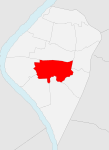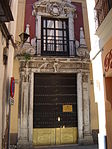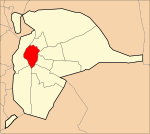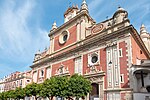Metropol Parasol
Buildings and structures in SevilleTourist attractions in SevilleWooden buildings and structures in Spain

Setas de Sevilla ("Mushrooms of Seville") or Las Setas ("The Mushrooms"), initially titled Metropol Parasol, is a wooden structure located at La Encarnación square in the old quarter of Seville, Spain. It was designed by the German architect Jürgen Mayer and completed in April 2011. It has dimensions of 150 by 70 metres (490 by 230 ft) and an approximate height of 26 metres (85 ft) and claims to be the largest wooden structure in the world. Its appearance, location, delays and cost overruns in construction resulted in much public controversy.
Excerpt from the Wikipedia article Metropol Parasol (License: CC BY-SA 3.0, Authors, Images).Metropol Parasol
Plaza de la Encarnación, Seville Casco Antiguo
Geographical coordinates (GPS) Address External links Nearby Places Show on map
Geographical coordinates (GPS)
| Latitude | Longitude |
|---|---|
| N 37.393252777778 ° | E -5.9918805555556 ° |
Address
Setas de Sevilla (Espacio Metropol Parasol)
Plaza de la Encarnación
41003 Seville, Casco Antiguo
Andalusia, Spain
Open on Google Maps











